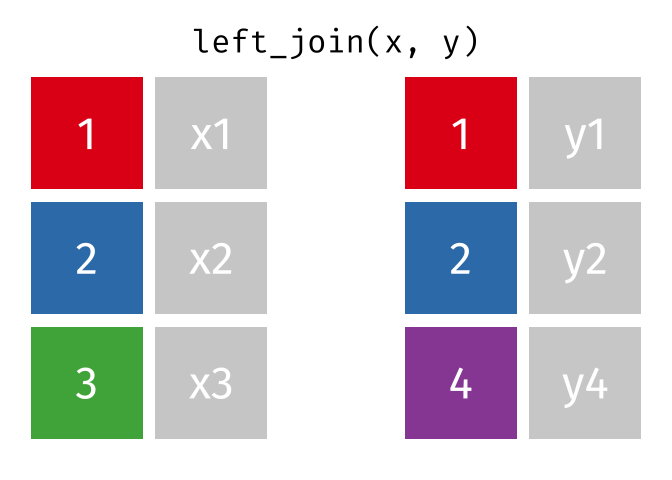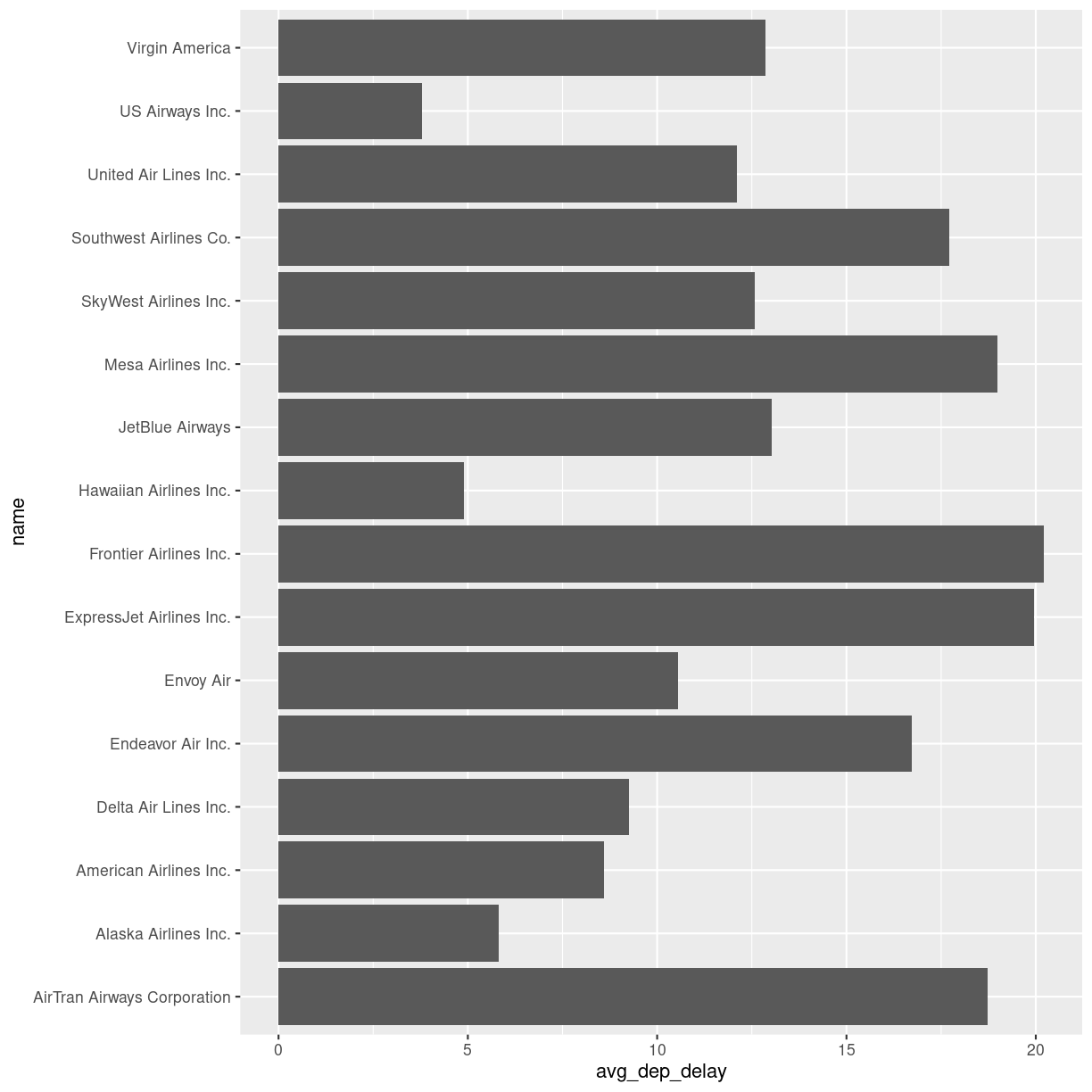Joining data
Overview
Teaching: 20 min
Exercises: 10 minQuestions
How do I import data from other sheets in a spreadsheet?
How do I enrich tables with additional data?
What is a join?
Objectives
Learn how to import data from sheet number 2 (and 3 etc) in spreadsheets
Learn how to join data frames
What is the actual name of the best airline?
It is nice to be able to identify the airline that is most on time. But we have carrier codes, not the actual names of them.
How do we get that?
Reading another sheet in a spreadsheet
Our spreadsheet contains more that one sheet. The second sheet contains the names and carrier codes of the relevant airlines.
We can read sheet number 2 from the Excelfile, by giving read_excel() a
second argument, specifying the sheet we want:
carriers <- read_excel("data/flightdata.xlsx", sheet = 2)
carriers
# A tibble: 16 × 2
carrier name
<chr> <chr>
1 9E Endeavor Air Inc.
2 AA American Airlines Inc.
3 AS Alaska Airlines Inc.
4 B6 JetBlue Airways
5 DL Delta Air Lines Inc.
6 EV ExpressJet Airlines Inc.
7 F9 Frontier Airlines Inc.
8 FL AirTran Airways Corporation
9 HA Hawaiian Airlines Inc.
10 MQ Envoy Air
11 OO SkyWest Airlines Inc.
12 UA United Air Lines Inc.
13 US US Airways Inc.
14 VX Virgin America
15 WN Southwest Airlines Co.
16 YV Mesa Airlines Inc.
We now have a second data frame, containing the names of the carriers. And we have a data frame containing the average delays
summary_delays
# A tibble: 16 × 7
carrier avg_dep_delay med_dep_delay sd_dep_delay max_dep_delay min_dep_delay
<chr> <dbl> <dbl> <dbl> <dbl> <dbl>
1 US 3.78 -4 28.1 500 -19
2 HA 4.90 -4 74.1 1301 -16
3 AS 5.80 -3 31.4 225 -21
4 AA 8.59 -3 37.4 1014 -24
5 DL 9.26 -2 39.7 960 -33
6 MQ 10.6 -3 39.2 1137 -26
7 UA 12.1 0 35.7 483 -20
8 OO 12.6 -6 43.1 154 -14
9 VX 12.9 0 44.8 653 -20
10 B6 13.0 -1 38.5 502 -43
11 9E 16.7 -2 45.9 747 -24
12 WN 17.7 1 43.3 471 -13
13 FL 18.7 1 52.7 602 -22
14 YV 19.0 -2 49.2 387 -16
15 EV 20.0 -1 46.6 548 -32
16 F9 20.2 0.5 58.4 853 -27
# ℹ 1 more variable: iqr <dbl>
what we would like is something like this:
# A tibble: 16 × 8
carrier name avg_dep_delay med_dep_delay sd_dep_delay max_dep_delay
<chr> <chr> <dbl> <dbl> <dbl> <dbl>
1 US US Airways In… 3.78 -4 28.1 500
2 HA Hawaiian Airl… 4.90 -4 74.1 1301
3 AS Alaska Airlin… 5.80 -3 31.4 225
4 AA American Airl… 8.59 -3 37.4 1014
5 DL Delta Air Lin… 9.26 -2 39.7 960
6 MQ Envoy Air 10.6 -3 39.2 1137
7 UA United Air Li… 12.1 0 35.7 483
8 OO SkyWest Airli… 12.6 -6 43.1 154
9 VX Virgin America 12.9 0 44.8 653
10 B6 JetBlue Airwa… 13.0 -1 38.5 502
11 9E Endeavor Air … 16.7 -2 45.9 747
12 WN Southwest Air… 17.7 1 43.3 471
13 FL AirTran Airwa… 18.7 1 52.7 602
14 YV Mesa Airlines… 19.0 -2 49.2 387
15 EV ExpressJet Ai… 20.0 -1 46.6 548
16 F9 Frontier Airl… 20.2 0.5 58.4 853
# ℹ 2 more variables: min_dep_delay <dbl>, iqr <dbl>
What we want to do is joining the two dataframes, so we enrich the original dataframe containing summary statistics on departure delays, with the name matching the carrier code.
Several different types of joins exist. The one we need here is left_join()
 .
.
With a left_join() we join the two dataframes. All rows in the left dataframe
are returned, enriched with the matching values from the columns in the right
dataframe. Rows in the left dataframe, that does not have a matching row in
the right dataframe will get NA-values.
Let us do that!
summary_delays %>%
left_join(carriers) %>%
relocate(name, .after = carrier)
Joining with `by = join_by(carrier)`
# A tibble: 16 × 8
carrier name avg_dep_delay med_dep_delay sd_dep_delay max_dep_delay
<chr> <chr> <dbl> <dbl> <dbl> <dbl>
1 US US Airways In… 3.78 -4 28.1 500
2 HA Hawaiian Airl… 4.90 -4 74.1 1301
3 AS Alaska Airlin… 5.80 -3 31.4 225
4 AA American Airl… 8.59 -3 37.4 1014
5 DL Delta Air Lin… 9.26 -2 39.7 960
6 MQ Envoy Air 10.6 -3 39.2 1137
7 UA United Air Li… 12.1 0 35.7 483
8 OO SkyWest Airli… 12.6 -6 43.1 154
9 VX Virgin America 12.9 0 44.8 653
10 B6 JetBlue Airwa… 13.0 -1 38.5 502
11 9E Endeavor Air … 16.7 -2 45.9 747
12 WN Southwest Air… 17.7 1 43.3 471
13 FL AirTran Airwa… 18.7 1 52.7 602
14 YV Mesa Airlines… 19.0 -2 49.2 387
15 EV ExpressJet Ai… 20.0 -1 46.6 548
16 F9 Frontier Airl… 20.2 0.5 58.4 853
# ℹ 2 more variables: min_dep_delay <dbl>, iqr <dbl>
The relocate function is used to change the order of the columns.
There are other join functions
left_join is an example of a mutating join. Like the mutate function
left_join introduces new variables, new columns, in our dataframe.
Mutating joins
The closes cousin of the left_join funtion is the right_join.
The left_join returns all rows on the left hand side of the join, augmented with values from the dataframe on the right hand side of the join, based on matching values.
The right_join function returns all rows on the right hand side of the join. Depending on the flow of our code, we choose the variant that best suit our purpose.
inner_join keeps only the rows on the left hand side of the join, that have matching values in the dataframe on the right hand side of the join. Whereas left_join and right_join keeps all rows, and add NA values where there is no match, inner_join only returns rows that have a match.
full_join on the other hand keeps all rows from both dataframes being joined. Any observations that does not have a match in the other dataframe, will have NA values added.
Filtering joins
These joins will filter rows from the left hand dataframe, based on the presence or absence of matches in the right hand dataframe.
semi_join returns all rows that have a match on the right hand side of the join. But not those that do not have a match.
anti_join returns all rows, that do not have a match on the rigth hand side of the join.
Can we plot the average delays with carrier names?
Yes we can!
We take the summary_delays dataframe, containing the average delays, and join it with the data on carrier names. We do not have to specify the column on which we are joining, since there is only one shared column name. We then pipe that result to ggplot, where we specify that we would like the delay to be on the x-axis, and the name of the carrier on the y-axis:
summary_delays %>%
left_join(carriers) %>%
ggplot(mapping = aes(x = avg_dep_delay, y = name)) +
geom_col()
Joining with `by = join_by(carrier)`

plot of chunk unnamed-chunk-7
Key Points
Data is often organized in separate tables, joining them can enrich the data we are analysing